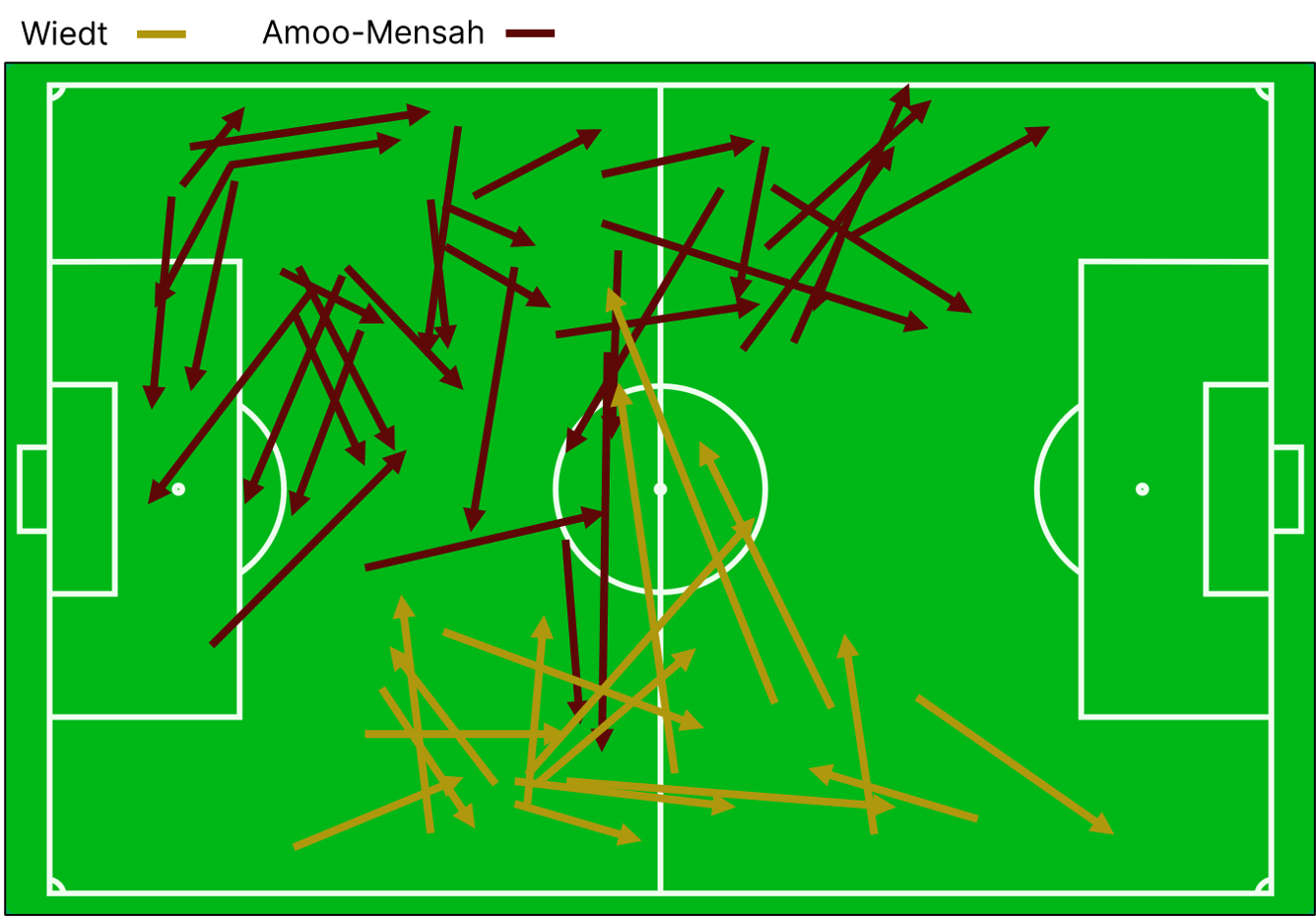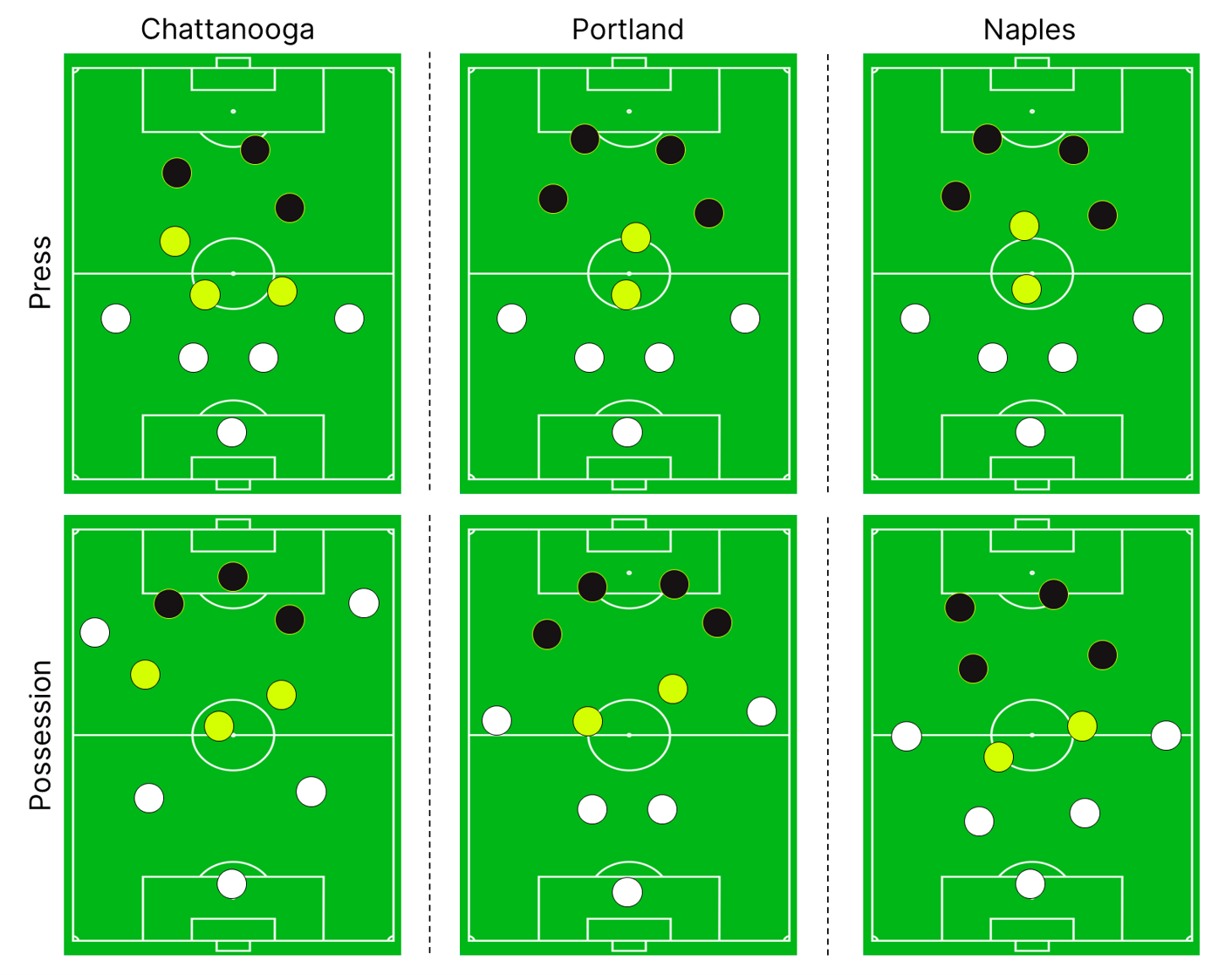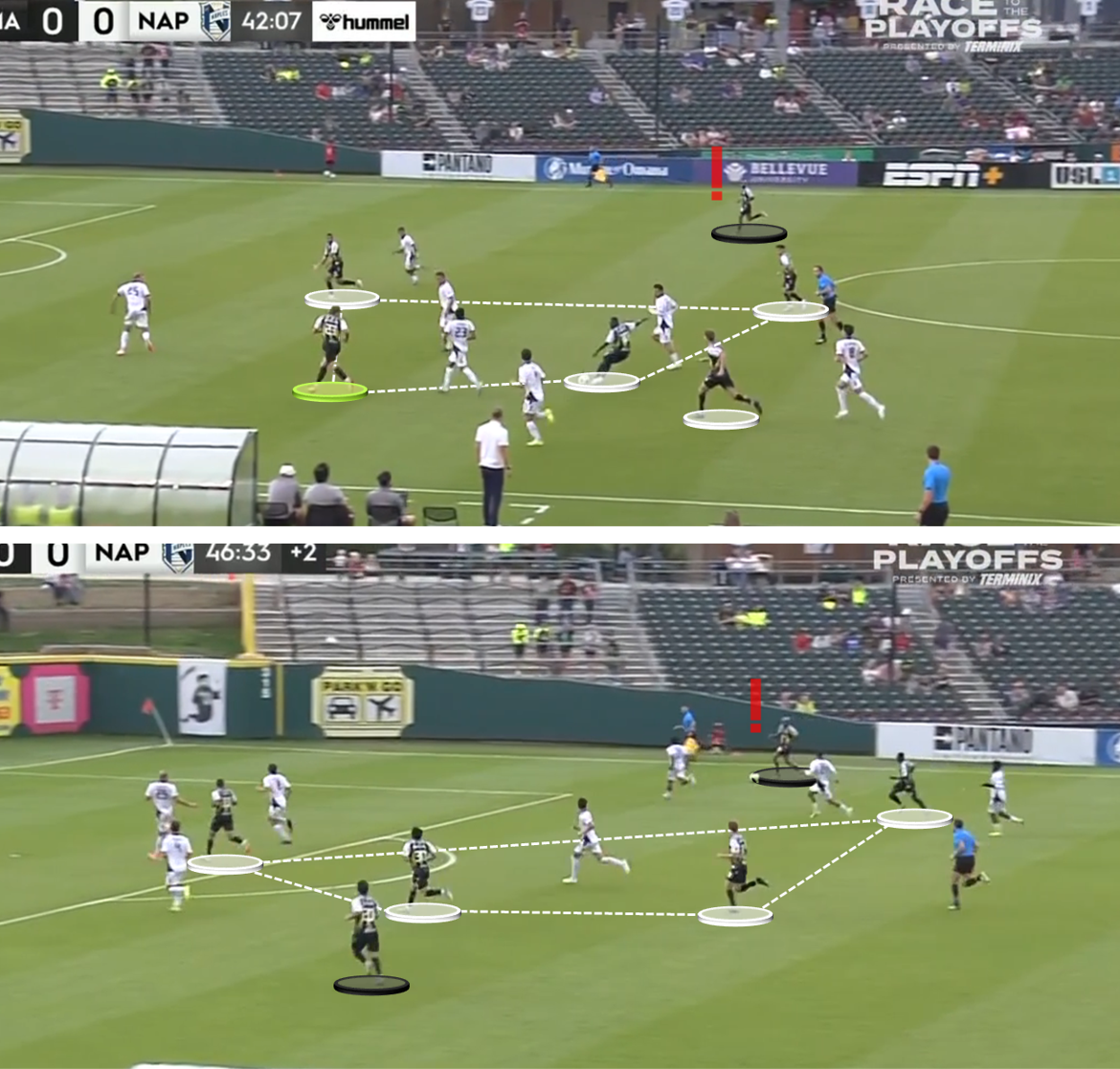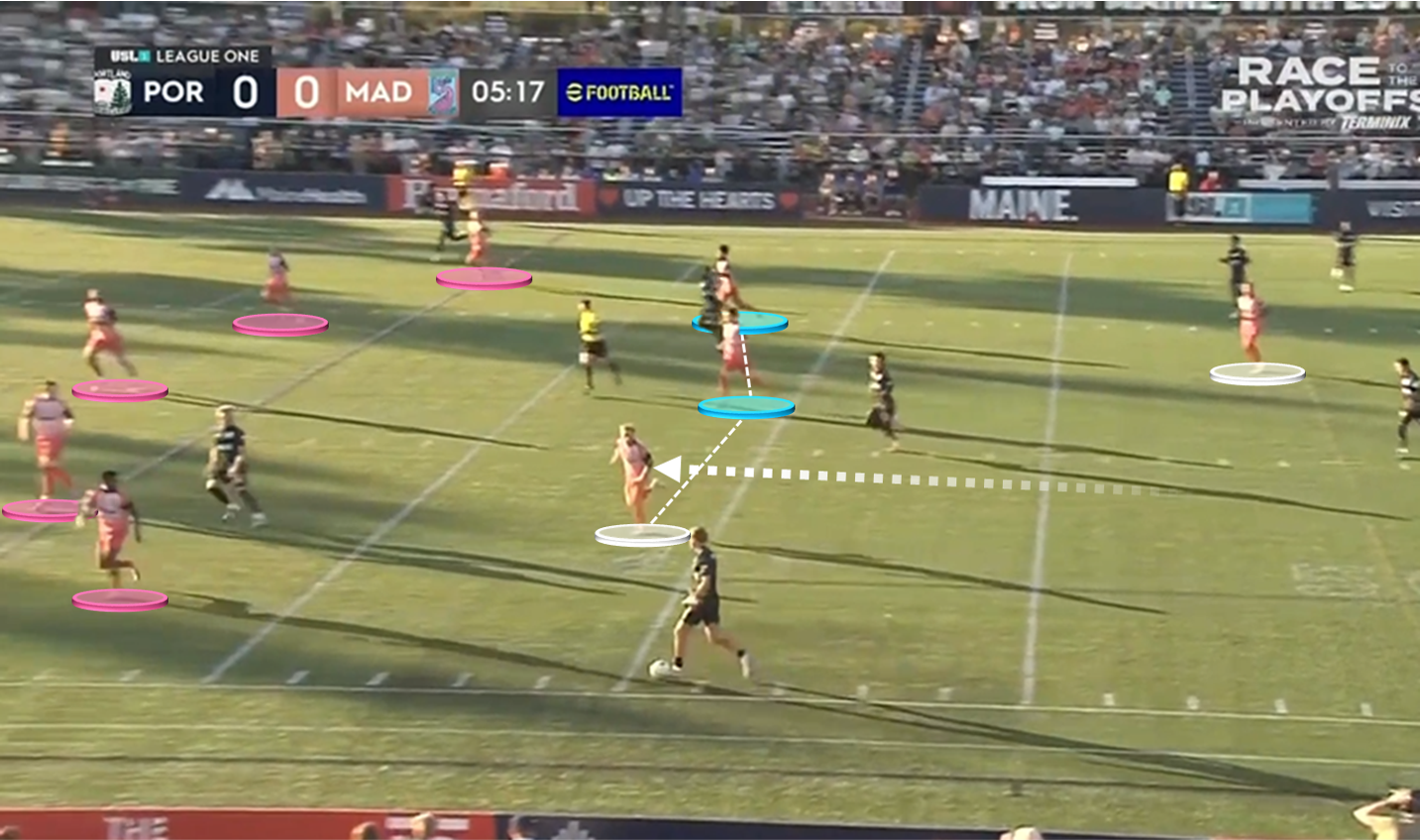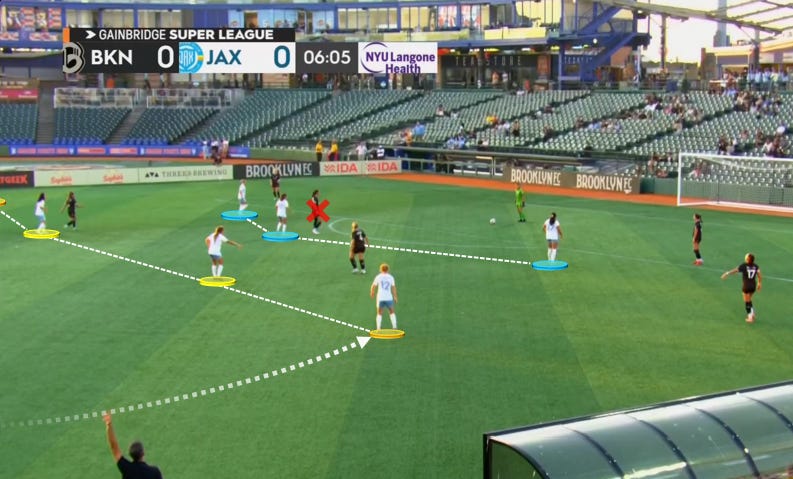The Back Four: Three Weeks Remaining
Featuring Latif Blessing, Omaha's shape(s), Brooklyn-Jacksonville, and more USL miscellany
Welcome in to The Back Four!
As always, check out Backheeled for more USL content, including Week 31 power rankings and a longform on the secrets to success in the Championship. Also, check out This League! for an audiovisual dive into the week that was.
Without further ado, let’s get to it.
Underappreciated Amoo-Mensah
Detroit bought themselves crucial breathing room on the Eastern bubble this weekend, downing North Carolina FC in a relatively comfortable manner to break a three-match losing streak. As is often the case in Le Rouge’s best performances, Devon Amoo-Mensah was at the heart of the victory.
Amoo-Mensah hasn’t missed a beat all season, to be clear. Across nearly 2,200 regular season minutes, the 29-year-old is taking 72 touches and winning more than six duels per 90 minutes. He’s been dribbled past just three times all year. Even with those strong numbers in mind, Amoo-Mensah’s performance stood out against NCFC.
North Carolina adjusted their press to shut down Detroit’s now-familiar build patterns, but their left-sided center back had the poise to overcome that challenge. Essentially, the guests shifted from a 5-4-1 system into a 4-4-2, a shape in which the right wingback and right winger each pushed ahead to crowd Detroit’s left.
Thus, you might be surprised to see the comparison between Amoo-Mensah’s pass completions compared to those of right-sided Shane Wiedt. Whether starting in his own 18-yard box to the side of goalkeeper Carlos Herrera or while making daring underlapping runs, Amoo-Mensah figured into every phase of play to manipulate the NCFC press.
I highlighted the relationship between Amoo-Mensah, left wingback Alex Villanueva, and midfielder Kobe Hernandez-Foster on Backheeled, but those three used fluid positional relationships to overload the press and work up the channel time and again. As a result, Amoo-Mensah attempted just four long passes, preferring to connect with Villanueva and Hernandez-Foster to carve upfield with control.
Crucially, Amoo-Mensah also knew how to turn defense into offense. North Carolina has been reliant on their right side in recent weeks, using Pedro Dolabella as an anchor in the halfspace and then curling wingback Ahmad Al-Qaq around him. That’s exactly what NCFC tries to do above; you can see Al-Qaq release upfield when the pass into Dolabella is hit.
Amoo-Mensah never lets the attacker breathe. There’s pressure on Dolabella’s back at every step, forcing him to bobble his first touch. As soon as that happens, the Detroit defender swims around him to take the ball away.
Most center backs would simply hit a sideways pass at this point. Instead, Amoo-Mensah carries play into the final third. Detroit thus has a three-on-one against an isolated center back, and while Amoo-Mensah waits too long to play Villanueva up the sideline, the idea here is tremendous.
That’s Devon Amoo-Mensah in a nutshell. He’s a premier defender at his position, but he provides upside on the ball that’s definitional to what Detroit is trying to do. This weekend’s win against North Carolina couldn’t have made Amoo-Mensah’s value any clearer.
Blessings on blessings
(Note: I’m reading this section title in Big Sean voice?)
I’ve wanted to write about Lexington for a few weeks, but they keep shooting themselves in the foot with red cards. In the meantime, we got nearly 40 minutes of Latif Blessing this weekend, and it’s worth looking at his performance as a preview of things to come in Kentucky.
For those of you that missed the hype cycle, Blessing’s addition is a big deal. Across his near-decade in MLS, the 28-year-old accrued more than 200 appearances and exactly 40 goal contributions. On talent alone, he’s immediately one of the best attacking mids in the USL – he contributed five goals and 70th percentile progressive carries for the Houston Dynamo literally last year!
Within LSC’s lineup against FC Tulsa, Blessing pressed next to Forster Ajago in the top line of a 4-4-2. In possession, he was far freer. The Ghanaian international only took 10 touches, and eight of them came in the defensive half. By roving all throughout the middle third, Blessing maximized his gravity and forced Tulsa to bend their shape. Amidst it all, his progressivity stood out.
Here, Lexington ekes through Tulsa’s high press, with the pivot of Speedy Williams and Blaine Ferri sitting deep. Blessing initially drops low to provide a short passing outlet, but he starts to curl toward the attacking zone as he reads the play.
Tulsa’s Boubacarr Diallo (the No. 6) is committed upfield. Alex Dalou (the right winger) is flying at the ball. Dalou often dropped in to try and mark Blessing, but he leaves him in this instance to try and press upfield. As such, there’s space to exploit.
Ferri is able to squeeze the ball into Blessing, who wastes no time to look upfield and find his teammates. Marcus Epps has cheated ahead, and Blessing right-foots a pass into his feet against an isolated back four. As left back Kieran Sargeant advances, Lexington creates a five-on-four – one that wouldn’t happen without Blessing’s nous in a deep position.
The attacker ultimately went seven-for-seven as a passer before subbing out, providing a level of clean technique that immediately shone. That’s only going to become clearer as the weeks go on. Lexington will need to figure out how Blessing, Epps, Ajago, and Michael Adedokun – not in the squad last weekend – can fit into one coherent lineup, but their new star man feels like a game-changing piece with the playoffs approaching.
A Post
Omaha revisited
Union Omaha is on fire. They’re unbeaten since August 16th, winners in seven of their last nine games. Through it all, Vincenzo Candela is thinking on his feet, adapting his system to the opponent at hand.
Last weekend, I used the end notes of this column to highlight Omaha’s shape in a victory against Chattanooga. Los Búhos defended in a very narrow 4-2-2-2 shape that was designed to win second balls and compress against the Red Wolves’ direct restarts. While Candela instituted an attacking 2-3-5 that was perfectly suited to break Chattanooga down, it’s that off-ball shape that serves as the overarching template for Omaha.
With the caveat that formations are highly flexible within a given match, I’ve tried to map Omaha’s in- and out-of-possession looks in their last three games. Against both Naples and Portland – two more wins – Candela’s side pressed in a 4-1-3-2 before shifting toward a 2-2-4-2ish offensive framework.
You can point out the fact that Hearts of Pine were heavily rotated last Wednesday, but Omaha still took them to task. The high press was designed to stunt Portland’s short build-out by compressing space against the pivot; Laurence Wootton and Ryan Becher took turns stepping high into the 4-1-3-2’s three-man attacking midfield to fill the pockets between the wingers. Becher was immense in the lower pocket, going five-for-five in aerial duels when Portland was forced long.
Offensively, Omaha’s 2-2-4-2 showed variability in the attacking zone. When I label the shape as such, I’m implying that the wingers play narrow in the attacking line, making room for overlaps from the fullbacks. As mapped above, however, left-sided winger Mark Bronnik was somewhat more expansive than right-sided Prosper Kasim against Portland.
You saw that pattern come alive on Omaha’s winning goal. Left back Charlie Ostrem underlapped inside of a wide Bronnik, mixing up the opposing back line. Meanwhile, Kasim picked his moment to curl around the edge of the dual No. 9s to find a pocket at the far post. One cross later, Omaha found their 1-0 edge.
Against a Portland team known for their aggressive pressure, the widened shape also allowed for 2-4-4 build-out that provided a necessary level of surety. If Hearts pinned Omaha, there were four forwards spacing wide with an ability to receive over the top. In the case of a turnover at the back, Omaha had a surefire rest defense setup in place.
That’s the case above. Ostrem enters the attacking half and gives possession away, but Becher and Wootton help to form a “2+2” resting base alongside the center backs. There’s never any panic, and a rotation toward the sideline immediately denies a counterattacking opportunity.
Similar patterns prevailed on Sunday night against FC Naples. Omaha went for less of a traditional two-striker look by deploying Chelo Martinez and Pato Botello Faz up top, and Martinez had a real tendency to drop in for touches. Still, Candela’s 2-2-4-2 design shone through; Mark Bronnik played like an inside forward whenever Martinez dropped in this time around.
Hopefully, you’re starting to get the gist. Omaha has a surefire structure, but they’re incredibly adept about making match-to-match changes to accentuate certain players within said structure.
Two examples paint the picture above. The first sees Max Schneider (“lightning yellow”) make a run all the way upfield like a forward, helping to create that boxy four-man block at the heart of the attacking shape. Bronnik (white, like the forwards) is the overlapping player on the ball side, and right back Dion Acoff is wide open for a switch on the opposite flank. Similar setup, different players in the second case. Acoff is on the ball here, about to hit a cross toward Botello Faz and Martinez as the effective No. 9s.
Omaha showed some slight vulnerabilities in their 4-1-3-2 pressing shape, particularly when Naples could play through lines and activate the Karsen Henderlong/Kevin O’Connor duopoly against an isolated No. 6. At the same time, Omaha’s high pressing alignment made short progression difficult – all while easing transitions into the offensive formation. Candela is taking risks to a certain degree, but the system is well-considered enough that the bets are almost always paying off.
It’s still an uphill battle if Omaha wants to claim a home playoff game, but they might be the odds-on favorite when the postseason arrives. Form is the thing that makes a difference in November, and no team is in better form than Union Omaha. That’s no fluke; it owes to Vincenzo Candela’s tactical clarity above all else.
Reports of Madison’s demise…
Amidst the ups and downs across the League One playoff bubble, I’ve tended to underplay Forward Madison’s chances to get over the line. Suddenly, however, Matt Glaeser and co. are riding high amidst a three-wins-in-four run that’s got them within two points of Charlotte for the #8 seed. It’s worth examining this weekend’s runaway win in Portland to see what’s going right.
When I last spotlighted Madison, I focused on their ability to tilt the pitch in Henny Derby win against the Richmond Kickers, and a lot of the same principles loomed large against Hearts of Pine. Those are two different opponents in terms of shape and style, but Madison managed to dominate the middle third in their 5-2-2-1 in both instances.
Portland is at their best when they can advance through the lines as quickly as possible while still maintaining control. When players like Masashi Wada and Ollie Wright find the ball in the final third, opposing defenses are in trouble – and especially so thanks to Portland’s counterpress. Madison designed their defense to deny those situations, relying on two key factors to do so: (1) a height-shifting back five and (2) intricate give-and-take between Derek Gebhard and Devin Boyce at the No. 10 spots.
Madison’s average defensive action came merely 35.6 yards upfield, but that number obfuscates the nature of the performance. The back five was willing to sit in low block and do a job, but it sat far higher as Portland’s short-from-the-back build initiated in order to minimize space between the lines.
The ‘Mingos tended to start in a 5-2-3 on paper, but as soon as Portland worked to one side, they’d drop one of those attackers – see Boyce in white above – into the midfield line. That setup accomplished a few things. In the screenshot, Boyce can step toward lethal left back Nathan Messer, allowing the pivot to stay home against Wada. Meanwhile, near-side wingback Nico Brown and center back Timmy Mehl can hedge against Wright. Portland has the chance to advance, but it’ll take superior skill to break through.
As a result of this dynamic, 82% of Hearts of Pines’ final-third entries came up the wings. To reiterate: less than a fifth of their movements into the attacking zone came up the middle. Madison couldn’t have asked for much better.
Not only did Madison excel in mid-low block, but they used their higher pressure to create short-field attacking movements. You see that above.
From the jump, Madison had Gebhard and Boyce soft man-mark Michel Poon-Angeron and Mikey Lopez in the Portland pivot. They’re walled off in the clip, so with neither player readily available, Hearts of Pine – a team that’s second-to-last in League One with a 47% duel win rate – need to go longer.
Madison is able to recover possession on the cusp of the midfield, and they immediately drop Boyce and Gebhard low to help push forward. Because they’re occupying a rather small patch around the center circle, Portland compresses in hopes of regaining the ball before the guests can settle.
That’s not what happens. Instead, Madison bait Hearts of Pine overly narrow, opening a switch into Brown with up the right sideline. It’s a considerate sequence that illustrates Forward Madison’s deep understanding of Portland’s counterpressing patterns, and it allows them to establish control.
Madison got on the board through another side-to-side move over a narrow Portland defense, with left-sided Damia Viader carrying the ball through lines to tee up Gebhard. The second goal came from the penalty spot, but it arose because of the high counterpress; both Boyce and Gebhard challenged Portland to prevent a clearance and force a turnover in the run-up to the penalty call.
It’s a little bit different from the possessive dominance that Glaeser usually wants to instill, but it’s keeping Madison alive. Pragmatism is the difference between playoff teams and also-rans, and Forward Madison is proving to be adaptable when it matters most.
Lessons from Brooklyn - Jacksonville
This weekend’s Super League draw between Brooklyn FC and Sporting Jax illustrated two things: Jacksonville is a real contender, and Brooklyn is nimble enough to make noise. As it stands, both clubs are sitting outside of the playoff spots, but there’s plenty to recommend each as a contender.
Jacksonville has a very specific style within their 3-4-3, using high pressure and aggressive defensive closing to create problems. This season, they lead the league in final-third recoveries (8.2) and interceptions (9.3) per game. That intensity is designed to create short-field moments in semi-transition, preferably driving into the feet of forward Ashlyn Puerta.
Still, Stacey Balaam’s unit isn’t one-note. More often than not, Jacksonville’s press yields wider chances and leverages Meg Hughes and Caroline Murray at the wingback spots. Those two combined for a relatively modest eight crosses against Brooklyn, but that included two chances created.
Meanwhile, Tomas Tengarrinha broke the mold for a Brooklyn team that usually uses a back three. His intent in moving toward a 4-1-2-3 last Saturday was simple: outnumber the opposing pivot with an energetic midfield three, and match up against three center backs with three probing forwards.
Brooklyn needed to tilt the field to make those matchup advantages pay off, and they couldn’t do it early on.
As part of their shake-up, Brooklyn used perennial holding midfielder Sam Kroeger as one of their elevated No. 8s. Meanwhile, center back Alice Barbieri stepped into the No. 6 role. The group was designed to win battles, yet Jacksonville won 58% of recoveries. Moreover, Barbieri was forced to be more of a sweeper than a regista; she went seven-for-18 as a passer in the first half.
Jacksonville’s tweaked 3-4-1-2 press dominated the first 45 minutes. As you can see above, the guests dropped their centermost forward (in blue) deeper in order to mark Barbieri. Additionally, the midfield line – wingback inclusive – pushed extremely high to clamp down in the attacking zone. Brooklyn had an impossible time working through that setup with short passing, and they struggled to connect with their front three using the long ball as an alternative.
Likewise, Brooklyn’s starting wingers felt disconnected defensively. Never was that clearer than in the 16th minute, when Sofia Lewis (starting right winger) was dribbled past by wide center back Grace Phillpotts, a former Brooklyn player. Jacksonville used a move-and-replace sensibility to freeze Lewis; as midfielder Sophie Jones dropped low, Lewis’ attention was divided and Phillpots thus could advance into open space. Phillpots then had a two-on-one with left-sided Hughes, whose ensuing cross would provide a go-ahead assist.
To Tengarrinha’s credit, Brooklyn completely re-thought the approach out of halftime. The changes were numerous: Ana Markovic subbed off for Emily Pringle; striker Rebecca Cooke shifted to the right wing in place of Lewis; Barbieri dropped to center back with Hope Breslin sliding upfield as a No. 8 and Kroeger restored to the No. 6 spot.
In the first half, Brooklyn put up just one shot. In the second half, they mustered three goals on 0.91 xG. Pringle was key, bringing a shoulder-to-shoulder energy off the bench that made the hosts far more dangerous with the long ball; a 56th minute sequence where she out-battled Jacksonville for the ball and dribbled her way to a shot was par for the course. Meanwhile, Barbieri felt more natural in a deeper role, with her passing abilities goading the Jacksonville press high and thereby opening space between the lines.
Brooklyn began to press higher in their own right, fanning fullbacks Leah Scarpelli and Nayeong Shin into the halfspace in more of a 2-3-2-3 posture. That practical Scarpelli-Kroeger-Shin defensive midfield line was hugely effective at stopping the ball, steadying Brooklyn until Tengarrinha made yet another change.
This time, Samantha Rosette – often the captain for Brooklyn in 2024 as a right back – entered on the right wing to help evolve the shape into a 4-2-4. With one less No. 8, Brooklyn gave themselves a four-on-three edge over the opposing center backs as they chased an equalizer.
You see the impact of the changes above. Rosette doesn’t touch the ball, but her presence draws Hughes upfield from wingback. Thus, wing-shifted Rebecca Cooke can receive in space off a direct throw-in, drawing a rotation from the Jacksonville pivot in the act. Cooke sees what’s happening, laying off the ball to an advancing Loving up the middle. Loving finds Pringle against the momentum of the defense, and a shot is on.
Now, don’t get it twisted: Jacksonville went on the road, earned a 1.6 to 1.1 xG edge, and picked up a point for their efforts. Their system was better from the jump, and it’s easy to see why they’ve come out of the gates hot in their expansion season.
That said, Brooklyn is finding themselves in the Tengarrinha era. It isn’t always pretty, but we’re getting useful experimentation with shapes and player deployments that should ultimately play off. What we saw in the second half against Jacksonville won’t be Brooklyn’s final form, but it’s another rung on the ladder to success.
Quick Hits
In other news this week…
I’ve talked a lot about Dayonn Harris in recent weeks, but Marlon Vargas has stepped up to the plate big-time for New Mexico United. He’s putting up 2.2 shots per game across the entire season, and he’s one of just three players in the Championship with 10-plus through balls despite playing only 1,400 minutes. I don’t know how United will fit him alongside a healthy Valentin Noel, but that’s a good problem to have.
One more reminder to watch this week’s episode of This League! whenever it comes out. Ryan, Peyton, and I dug into the Jagermeister Cup final and then spent a colossal amount of time combing through the Championship’s all-league picture.
Shoutout to the Carolina Ascent, who took my criticisms from last week to heart by upping their press and shifting Mia Corbin into the pivot. The best way to avoid mistakes in low block? Press so high that you’re always in the attacking half.
I regret to declare that the new Taylor Swift album isn’t very good. The heart wants what it wants, so I’m disappointed to say that the track about Travis Kelce’s privates might be the best song on the album.
It’s Park Chan-wook week (Park chan-week?) around these parts. On back-to-back days at the end of the week, I’m seeing The Handmaiden – the single greatest movie of the 21st century so far – at a rep screening and Park’s brand-new No Other Choice at NYFF. Park is a sicko who does magical things with the camera, and I couldn’t be more excited.

